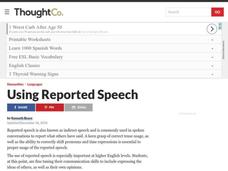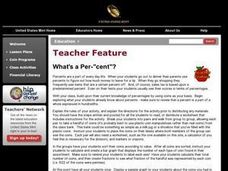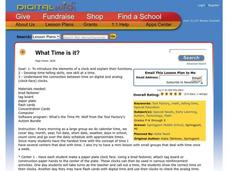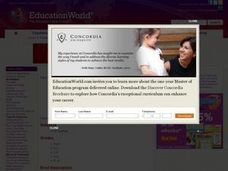Curated OER
Lost King of the Maya
Students are introduced to the Mayan Long Count calendar system. They work in groups to calculate the date of their birth and use the calendar to determine important Mayan dates.
Curated OER
Money
First graders explore money. In this coins value lesson, 1st graders discover the values of all the U.S. coins and practice arranging them in order to buy objects. They will play a game as a class to practice the skill of using money to...
Curated OER
Giggle, Giggle, Quack Pizza Fractions
Students explore the concept of multiplication by using pizza. They read an article discussing how math is used everyday. They try to determine how many pizzas they would need to feed the class.
Curated OER
Weather Report Chart
Students complete a weather report chart after studying weather patterns for a period of time. In this weather report lesson, students measure temperature, precipitation, cloud cover, wind speed, and wind direction for a month. Students...
Curated OER
Using Reported Speech
Students fine tune their communication skills to include expressing the ideas of others, as well as their own opinions. They must practice a number of times before feeling comfortable using them in every day conversations.
Curated OER
Opportunity Cost
Students study what opportunity cost is and why it is important to their lives.
Curated OER
What's a Per-"cent"?
Students recognize the mathematical connections between fractions and percents. They develop and study graphs to make connections between their data and what it represents. They write about the connections they have discovered.
Curated OER
Primary History: Roman Shopping
In this Roman lifestyle worksheet, learners read about shopping during Roman times and study the various goods for sale. Students then count the cost for the shopping lists using the Roman numeral chart.
Gwinnett County Public Schools
Analysis of the Tuck Everlasting and The Birchbark House Text Exemplars
Looking to introduce some text-based questions into your ELA lessons? Practice the kinds of skills the Common Core demands with the seven text-based questions and the essay prompt provided here. Designed to be a three-day lesson, day one...
Illustrative Mathematics
Lake Algae
Introduce learners to exponential growth with this real-world problem about algae that is rapidly spreading across a lake in a city park. The task presents the rate of growth and an end value and asks learners to determine what happened...
Curated OER
Fred's Fun Factory
Round and round and round she goes. Where she stops, nobody knows. This activity uses a common arcade game of chance, the spinning wheel, as a platform for computing expected values, interpreting results, and applying this knowledge to...
Illustrative Mathematics
Fred's Fun Factory
Spin to win! Individuals calculate the average number of tickets expected based on a probability distribution for the number of tickets per spin. Pupils use that information to determine the average number of tickets that can be won...
Worksheet Web
Learning About Rate
After reading a one-page passage on how to understand and solve distance/rate problems, young mathematicians answer six word problems that have them correctly set up the formula in order to solve for the distnace, rate, or time in the...
National Council of Teachers of Mathematics
The Game of SKUNK
Do I stand or do I sit? The class plays a dice game where they must decide to either continue to stand and play or sit down and keep their points. After the game, groups discuss individuals' strategies and see connections to the...
Curated OER
Why Study Fractals?
Students explore the concept of fractals. In this fractals lesson, students use the website to research where fractals occur in nature. Students research what fractals are and how fractals are used to solve real world problems.
Curated OER
Light Plants and Dark Plants, Wet Plants and Dry Ones
Young scholars plant sunflower seeds in plastic cups, and once germinated, these are exposed to different conditions of light levels and/or soil moisture contents. Students measure growth of the seedlings every few days using...
Curated OER
What Time is it?
Young scholars participate in three centers focused on developing time-telling skills. In this time lesson, students create their own paper plate clock face, play "Time Concentration" using times on the hour and half hour, as well as,...
Curated OER
Four Corner Fun: A Review Game
Twelfth graders practice academic skills by answering multiple choice questions. They role-play as fibbers or players and respond to questions accordingly, going to the A,B,C, or D corners of the classsroom. Fibbers can go to any corner.
Curated OER
Telling Time: Elapsed Time
Students review time telling skills and are introduced how to determine the time before or after an interval of hours. They then determine the time at the end of an interval of hours and minutes and solve problems about elapsed time.
Curated OER
Refrigerator to Renoir: Ten Great Art Lessons on the Net
Every learner can be an artist with a series of activities designed to access their creativity. With reference links and instructional ideas, this art resource is sure to enrich your class and bring new ideas to even your most reluctant...
Curated OER
We Can Solve This Problem
For this story problem worksheet, 3rd graders study the steps to solving a word problem. Students respond to seven multiple choice questions and then answer three more practicing the steps with a given story problem.
Curated OER
Data Handling: Bus Charts
In this data display and analysis worksheet, students study a bar graph that shows the number of people who ride the bus at different times of day. Students use the graph to solve 6 problems. Note: Bus times are shown in 24 hour clock time.
Curated OER
Gullah Activities
Pupils study the Gullah culture by watching a video about Gullah, Gullah Island. They discuss the customs and crafts of the people such as basket weaving, food preparation, pottery, and quilt making. While working in centers, they make a...
Curated OER
Introducing the Concept: Proportions
Students measure distances. In this proportions lesson, students use a map to find how far it is between different cities. Students use their knowledge of measurement, multiplication and fractions to find the distances.























